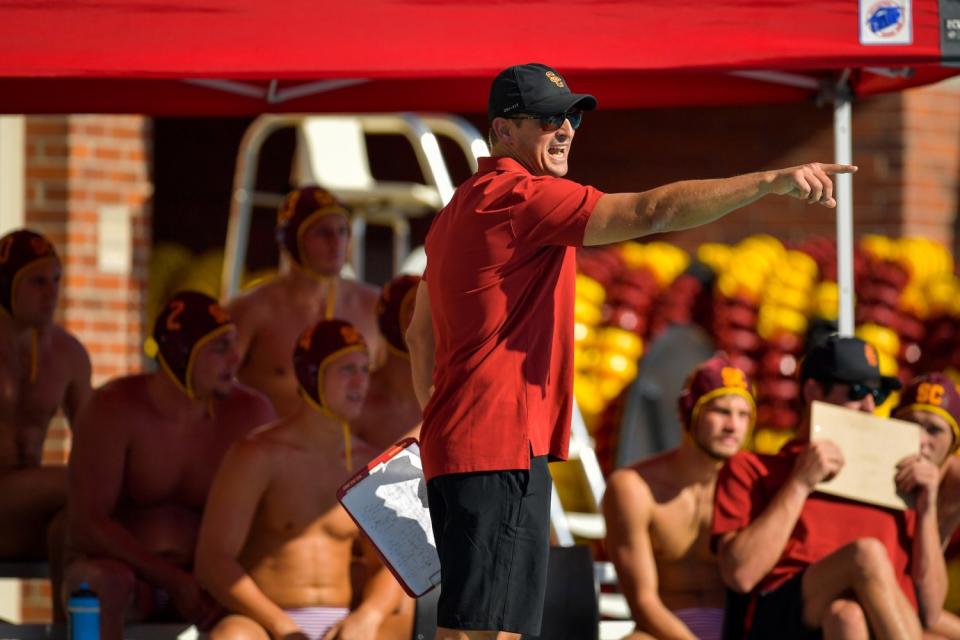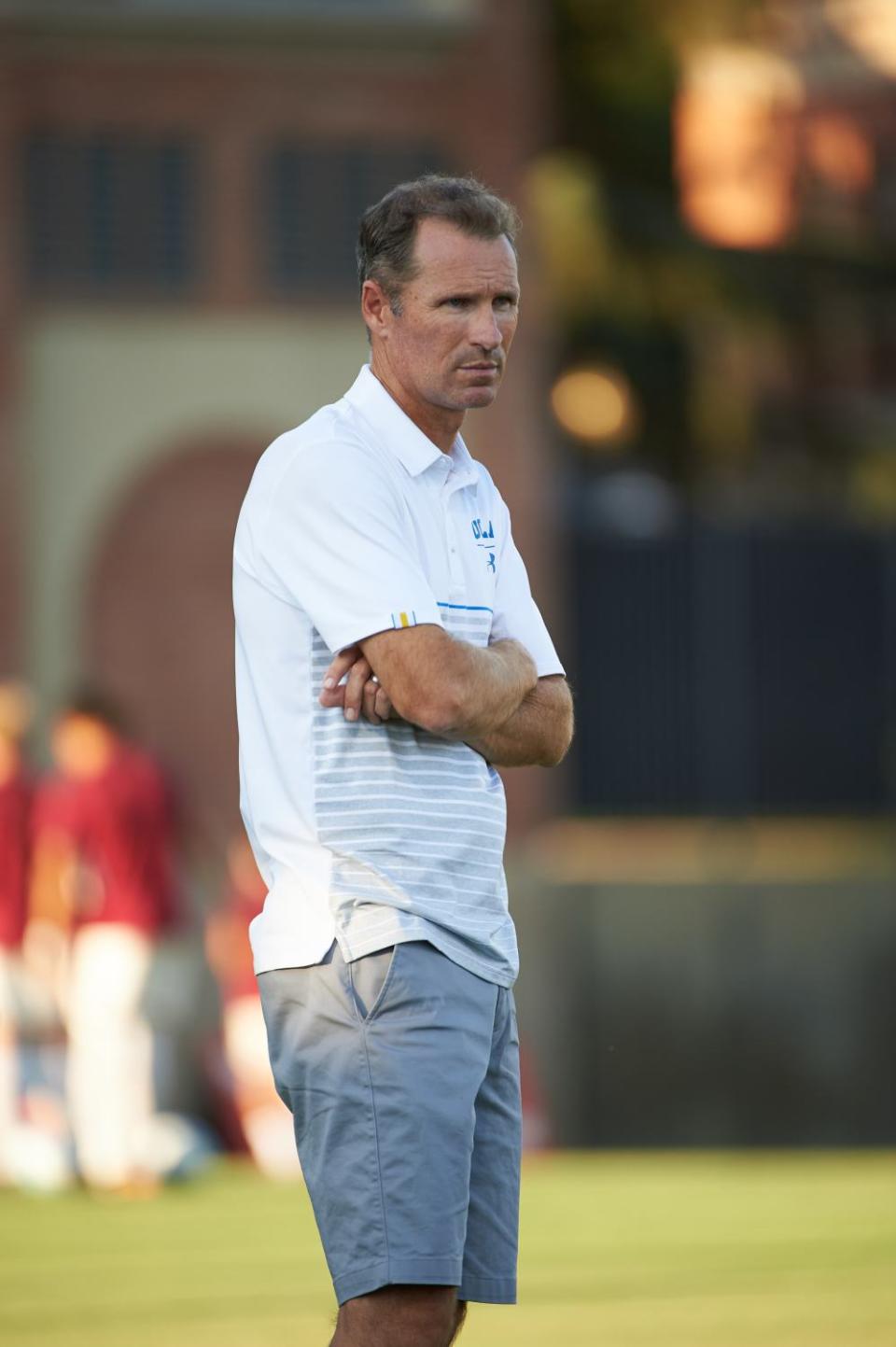NCAA cancellations create frustration for Olympic sports athletes at USC and UCLA

Kaylie Collins watched from the sideline as the USC women’s soccer team won the NCAA championship in 2016. The goalkeeper was redshirting her freshman year when the Trojans won their second NCAA title. Since then, she’s made it her goal to help the program win its third.
Now a senior, Collins is not sure if she’ll get her final chance to make that happen.
While individual conferences decide whether to play fall sports amid the COVID-19 pandemic, often with football at the forefront, those disparate decisions have already had major NCAA tournament implications for all fall Olympic sports. NCAA President Mark Emmert said Thursday in a video released on Twitter, “We cannot now, at this point, have fall NCAA championships” due to the number of schools that backed out for the fall.
The Board of Governors declared that if 50% or more of eligible teams in a particular division cancel their fall seasons, there can’t be a fall NCAA championship. Emmert said all NCAA Division I fall sports — which is everything except for FBS football — have fallen below that threshold as more than a dozen conferences, including the Pac-12, Big Ten, Mountain West, Mid-Atlantic and Ivy League, have postponed fall sports.
In deciding to suspend all sports through 2020, the Pac-12 had hopes to move competitions to spring. Now the conference that prides itself on Olympic sport success must wait to see if the championship tournaments will follow.
“We’re competitive athletes. We want to win the whole thing,” Collins said. “To not have that as our guiding force, our compass, it would be difficult.”
The Division I Council will officially rule on fall NCAA championships on Aug. 21, and if championship tournaments are postponed, information about rescheduling will follow at a later date.
Emmert mentioned the possibility of using predetermined sites for tournaments, similar to “bubbles” created by professional leagues. There could be smaller bracket sizes.
Moving the NCAA championships would be a logistical nightmare, UCLA men’s water polo coach Adam Wright recognizes, but the same could be said for most of this year. The coach who led the Bruins to three national championships in four years hopes that the NCAA, the schools and the conferences can combine for a creative solution to pull at least one bright spot out of an otherwise dark year.
“That would give them so much in really what has been a tough year,” Wright said. “I think everybody’s looking at ’21 and hopefully things are better, but how can we capture some bit of good or a positive thing for these student athletes?”
The Mountain Pacific Sports Federation — the conference the oversees teams like UCLA, USC, California and Stanford in water polo — said Wednesday in a statement postponing its men’s water polo season that the NCAA’s decision regarding the fall championships will inform how the conference proceeds for winter or spring schedules. For some coaches, a spring season could present a unique challenge: Wright and USC’s Marko Pintaric also coach the women’s teams at their respective schools in the spring after coaching the men in the fall.

Both coaches say if there is overlap, their staffs can rally to make the situation work.
"Let’s say we have a season, which we still don’t know, but hopefully we can have the format that can accommodate both," Pintaric said. "But in any format, between us coaches, we still have enough expertise and experience to lead both teams to be equally successful."
The Pac-12's decision Tuesday to postpone fall sports prompted more questions than answers. There are seniors on track to graduate early who now must search for minors or graduate programs to remain eligible for a delayed spring season. There are concerns about how to manage a roster that’s full of players with extra eligibility but strapped by NCAA scholarship limits for years to come. There are soccer players who hoped to start their professional careers. The NWSL and MLS drafts typically take place in January.
Spring sports teams went through a similar litany of problems when their seasons were suddenly canceled in March. To have to confront the same circumstances five months later feels “surreal” for USC women’s soccer coach Keidane McAlpine.
“That’s frustrating," McAlpine said, "but that’s just where we are.”
The Pac-12 cited recent findings that linked the novel coronavirus to myocarditis, a heart condition that results in inflammation of the heart muscle, as a reason to pause fall sports. Research about the novel virus and its long-term effects is still developing, but risks of the unknown were too much to push aside, even as athletes dedicated themselves to a return by getting their temperatures taken every day, filling out surveys and wearing a mask during voluntary workouts.
“The logistical side of me is understanding,” Collins said. “If I were put in that situation where I had to make that decision and had the health of the athletes on the line, I probably would have made the same decision. But it’s the more emotional side of me that is hurting and disappointed and frustrated.”
The mix of emotions also contained some hope. The fall season was already going to be delayed and condensed with no nonconference matches, coaches reasoned. A spring season can still resemble something more normal.
For men’s soccer, it gives the sport a chance to test its proposal for a split season. The idea of starting a season in the fall and finishing it in the spring has been in the works for years. The plan, which was supposed to go to an NCAA vote in April before it was tabled in the COVID-19 whirlwind, was proposed in the interest of player safety.

Instead of condensing a season into three months, often playing twice in three days, the plan reduces the number of games and redistributes them across two semesters: two exhibition and 12 regular-season matches during the fall and one exhibition and eight regular-season matches in the spring. Postseason tournaments would follow in the spring.
“In a lot of ways, us playing in the spring, it’s not something that we weren’t already discussing,” UCLA men’s soccer head coach Ryan Jorden said. “I’m disappointed that we’re not having a fall season, but for three or four months now, I’ve had a sense that this was probably the best decision because of all the uncertainty of even trying to get a fall season to come off. I look at this really optimistically.”
At this point, any spring season is still a hopeful hypothetical. It’s contingent on advances in understanding about the virus and rapid testing and improvements in case numbers. It’s even more complicated at the college level, where schools answer to their county officials, their conferences and the NCAA.
Collins said the Trojans are “exhausted” from the emotional roller coaster. They tried to remain ready only to get knocked back repeatedly when workouts were delayed and nonconference games were canceled. Being allowed to be around each other, even if they can only pass from socially distanced positions, would make the mental challenge easier, Collins said, because the hope for a championship tournament still flickers.
“There’s this resilience in everyone I think to kind of get themselves back into an optimistic mind-set,” Collins said. “[The NCAA tournament is] always going to be a driving force for people, like OK, if there’s a possibility for this, then we gotta stay ready.”

